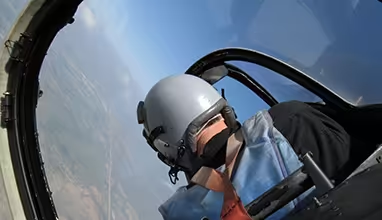This article focuses on helping aspiring Aerobatics Pilot learn about the eligibility criterion, aptitude and training required to make it as an Aerobatic Pilot.
Step 1: Study the Job Profile of an Aerobatic Pilot
The skills, qualifications and talent of an Aerobatic Pilot far exceed those required of a regular pilot, which is why it is important to understand the demands of the job physically and mentally before deciding on becoming one. As an Aerobatic Pilot, your job requires you to explore the limits of your airplane under challenging, often adverse, weather conditions by applying highly specialized technically supported precision flying strategies in a custom created stunt airplane.
Step 2: Understand the responsibilities of taking Aerobatic Flight as unique
As an aspiring Aerobatic pilot you need to have the ability to perform ‘sky dance’ routines and thrilling acts using special airplanes along vertical as well as horizontal flight paths, not just straight-line flying. You will be required to fly your custom created airplane through dizzying routines under physically demanding conditions to deliver spins, slides, rolls, loop and tumble flying at high speed – negotiating various factors that influence safe, yet thrilling novel aerobatic acts.
Step 3: Gain Experience in Acrobatic Flying after Earning Your PPL
Once you’ve acquired your PPL and feel you are ready to take up stunt flying, enroll at an aerobatics school or organization like the AOPA (the Aircraft Owners and Pilots Association). Places like these can help you log special flight time with an aerobatics instructor so you get first hand experience and valuable feedback on your piloting skills. Now you can improve on primary flying skills with guidance from a skilled professional who will help you acquire essential Spin Training.
Step 4: Join A Local Acrobatic Flying Chapter and Enroll in Stunt Flying Competitions
Sign up with the local IAC Chapter so you have access to vital stunt flying related data, advice and can network with more pros for upgrading your skills and certifications. For example, volunteering at a regional contest will give you the chance to learn about judging criterion. Then, you can take additional training for acquiring these yourself in order to log more practice hours and enter competitions for fun and gaining experience!
Step 5: Attend more Air shows; Get more Certifications, Progress At Your Pace
By attending more air shows, you will learn about novel stunt flying techniques and levels of competition, which you can aim at reaching yourself by developing the higher skill sets needed for these. Improvise flying sequences under the guidance of an experienced acrobatics instructor, practice safe altitude flying and the techniques for control recovery by internalizing proven strategies like Beggs-Mьller or other effective loss of control counter-measures. This knowledge will ensure recovery from various dangerous stunt-flying positions such as inverted, accelerated, crossover or flat spin techniques using aerobatic planes.
Step 6: Learn about possible downsides of Aerobatic Flying, Practice Safe Flying, and Clock More Contest Heights For Getting Ahead
Learn about the realistic downside of being a stunt pilot, so you don’t end up as a statistic like some fellow aspiring ‘Eagles’ do. Ensure your gear (parachute and safety equipment) is always adequate for your chosen routines, the airplane is well maintained and you are in top physical condition for no possibility of counter-indicate flying. Practice stunt flying at figures of contest heights away from congested areas to ensure unwaivered airspace experience and you can rest assured of being a successful aerobatic pilot.






